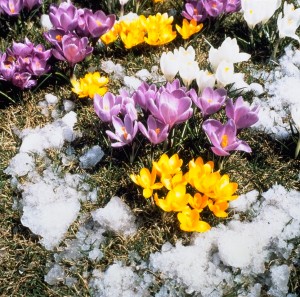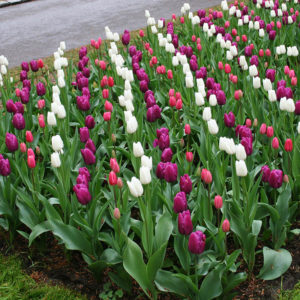Oh no! My bulbs are already sprouting! What do I do?
“My daffodils are starting to come up…the problem is that it is starting to snow a bit. Should I cover up the green that has started to sprout? I don’t want them to die!”
~Tammy from Cincinnati, Ohio
Does this sound familiar? At the middle to end of winter, we all hope for those warmer days with bright sunshine. But what about when those days come in the middle of January or February before the spring is really here? Oftentimes, these “touches of spring” can cause premature sprouting of bulbs. The growth starts showing itself above the ground, giving us hope of warmer days to come, only to be smothered with snowflakes a week later. So what is the best plan of action in a situation like this?
Well, my first piece of advice is simple: do not worry too much. If your bulbs are starting to come up early, they are simply reacting to the weather around them, which is out of your control. Think about it this way: if these bulbs where growing in the wild (as they originally did), they would experience this same thing from time to time and would still flourish without the intervention of any human. A little bit of foliage growth during freezing temperatures is not a big deal for these bulbs and should not affect their flowering in the months to come. If this happens in the wintertime, chances are that more cold weather is on its way. In this environment, the foliage will yellow and die back, returning the bulb to its “dormancy” period. This is completely normal and should just be allowed to happen.
Now if the weather continues to stay unseasonably warm, there is a slight chance that the bulbs may begin to produce flower buds. If this happens, your intervention may be necessary in order to protect these buds. Simply find some dry leaves, straw, or even sawdust to cover the sprouting plants and buds. Once the weather begins to warm and the threat of frost is gone, uncover the plants and allow them to continue to grow as normal. If the frost does happen to get to these flower buds, those flower buds will be damaged for the current season. However, this does not necessarily mean that the bulb will not produce additional flower buds at the proper time and then bloom as it normally should. Also, this one-time “frosting” will not have any adverse affect on the bulb’s performance in the years to come.
One more quick thing to keep in mind: sometimes bulbs sprout prematurely simply because the weather is unseasonably warm. However, sometimes there are factors we as gardeners create which can cause this premature sprouting. These factors are planting time and planting depth. Be sure that you wait until the weather is cool enough (consistently in the 40’s at night) in the fall to plant your spring blooming bulbs. Use the thermometer as your gauge and not just the calendar…as we all know, weather can be unpredictable and does not always turn cool at the same time every year. Planting your bulbs too early can cause them to then sprout too early. Also, keep in mind that most bulbs should be planted three times their height in depth. For example, if the bulb you are planting is approximately 2″ tall, then the top of this bulb should be covered with approximately 6″ of soil. Planting bulbs too shallow can cause premature growth as well.
Hopefully this article will calm some of your fears regarding your eager spring blooming bulbs! The most important thing to remember is that in most cases, nature can take care of itself. As long as your bulbs are planted correctly, your spring garden will be absolutely beautiful!
Have a question for Bridget? Email her at bridget@bulbblog.com. If Bridget features your question in a blog post, you’ll receive a $5.00 coupon from one of our sponsors Holland Bulb Farms! Congratulations to Tammy for receiving her coupon!




